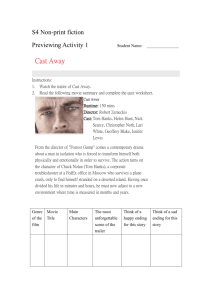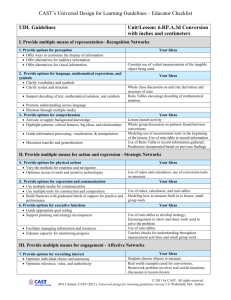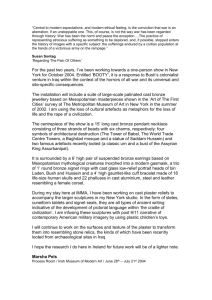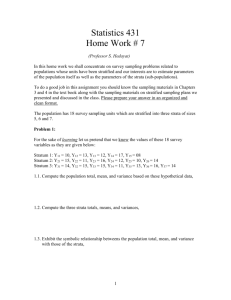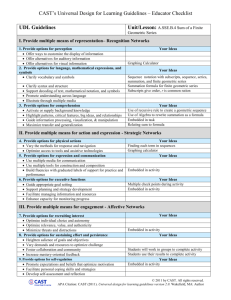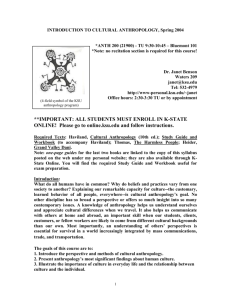Final Paper
advertisement
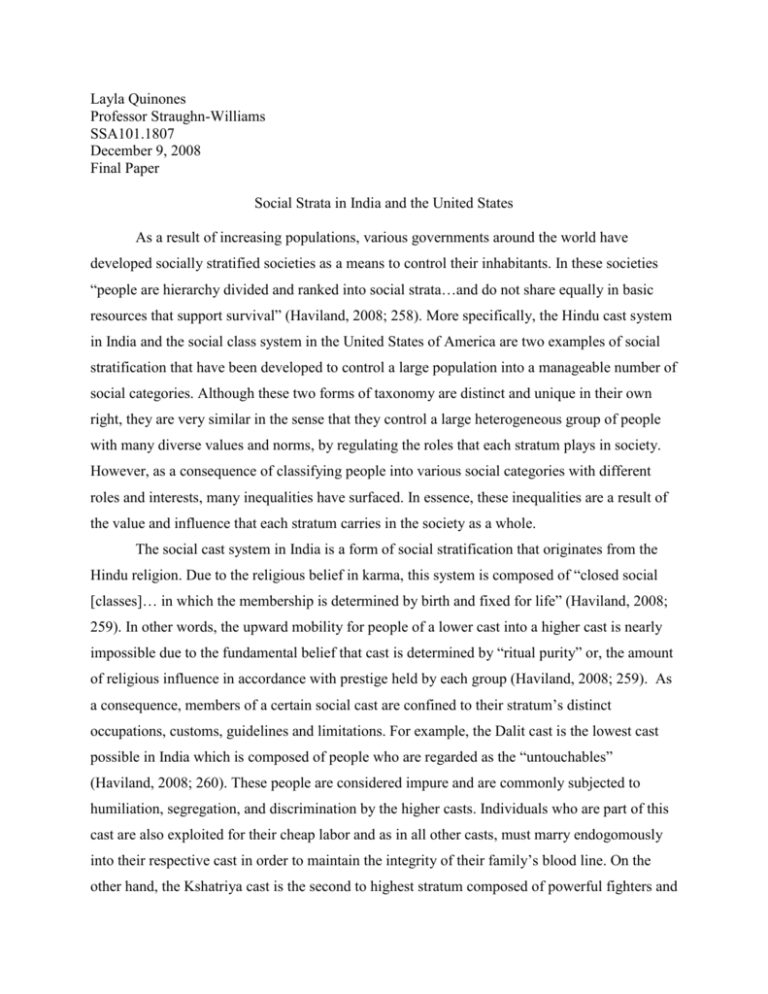
Layla Quinones Professor Straughn-Williams SSA101.1807 December 9, 2008 Final Paper Social Strata in India and the United States As a result of increasing populations, various governments around the world have developed socially stratified societies as a means to control their inhabitants. In these societies “people are hierarchy divided and ranked into social strata…and do not share equally in basic resources that support survival” (Haviland, 2008; 258). More specifically, the Hindu cast system in India and the social class system in the United States of America are two examples of social stratification that have been developed to control a large population into a manageable number of social categories. Although these two forms of taxonomy are distinct and unique in their own right, they are very similar in the sense that they control a large heterogeneous group of people with many diverse values and norms, by regulating the roles that each stratum plays in society. However, as a consequence of classifying people into various social categories with different roles and interests, many inequalities have surfaced. In essence, these inequalities are a result of the value and influence that each stratum carries in the society as a whole. The social cast system in India is a form of social stratification that originates from the Hindu religion. Due to the religious belief in karma, this system is composed of “closed social [classes]… in which the membership is determined by birth and fixed for life” (Haviland, 2008; 259). In other words, the upward mobility for people of a lower cast into a higher cast is nearly impossible due to the fundamental belief that cast is determined by “ritual purity” or, the amount of religious influence in accordance with prestige held by each group (Haviland, 2008; 259). As a consequence, members of a certain social cast are confined to their stratum’s distinct occupations, customs, guidelines and limitations. For example, the Dalit cast is the lowest cast possible in India which is composed of people who are regarded as the “untouchables” (Haviland, 2008; 260). These people are considered impure and are commonly subjected to humiliation, segregation, and discrimination by the higher casts. Individuals who are part of this cast are also exploited for their cheap labor and as in all other casts, must marry endogomously into their respective cast in order to maintain the integrity of their family’s blood line. On the other hand, the Kshatriya cast is the second to highest stratum composed of powerful fighters and Quinones 2 rulers (Haviland, 2008; 260). These people are the governing class of India who are considered very wealthy, prestigious and perceived as close to the Gods therefore, they were born with the privilege to govern their societies. Furthermore, the religious belief in karma conditions people of lower casts to behave accordingly, so as to not jeopardize their upward movement into higher categories when they are reincarnated. A similar system of stratification is the class system used in the United States. As seen in the film People Like Us, this system is composed of an upper, middle and lower social class in which its members share interests, opinions and a common outlook on life. Like in India, individuals are usually born into their respective classes giving them certain limitations and guidelines to follow. The upper class is composed of social elites who are wealthy and usually become powerful figures in society, such as politicians or the owners of major corporations (Louis Alvarez and Andrew Kolker, 2001). On the other hand, the lower class is composed of hard working people who are poor and usually stay within their strata due to race, lifestyle and the occupations that are available to them with little or no opportunity for upward mobility. For example, Karen Brodkin Sacks asserts in her article “How Did Jews Become White Folks,” that “the United States has a history of anti-Semitism and of beliefs that Jews [and African Americans] were members of an inferior race” therefore, they were classified as low-class and, not given the privileges and opportunities that the Anglo-Saxon Americans of the upper-class were given (1996; 79, 87-88). As a result, many forms of oppression and social inequality are present in the lower classes of the American class system. Although the systems of stratification in India and the United States contrast greatly, they both are fundamentally similar in many ways. In both countries, social class determines an individual’s profession, associates, language, diet, opportunities and overall lifestyle. For example the lowest casts in India, the Dalits and the Shudras, are considered servants for the higher strata. (Haviland, 2008; 260) In America, the middle and lower classes are considered working classes in which individuals provide services for the wealthier upper class. Generally, both societies are governed by individuals who are considered social elites and the most “pure” of people in the society. This dominant status allows them to impose their opinions on society and therefore, create a universal norm that should be followed by the country’s inhabitants. F. James Davis points out many aspects of social class systems in his article “Who is Black?” He states “it is the position on the class ladder...that determines who gets into the club,” the Quinones 3 “wealthier whites [exploit] and [control] the poor whites and [encourage] anti-black attitudes and actions to keep blacks under control” (1991;102). In the United States as well as in India, individuals who are a part of the lowest stratum are oppressed and treated unequally in the sense that they work more, do not have as many opportunities, and are exploited by the higher strata. Here, Davis also touches on the fact that those who are in the lower classes are encouraged and conditioned to stay within their respective stratum. He also notes that in the United States, individuals who have governed the country have originated from the upper class, are wealthy, associate with other politicians and have studied at the most prestigious schools in America. This idea of a “ruling class” also exists in India where warriors and rulers are exclusively from the Kshatriya cast and, those who make the laws are from the highest cast the Brahamans (Haviland, 2008, 259-260). In both societies, social stratification ensures that those with social prestige will govern the country according to similar values and lifestyles that are based on the “ideal” way of life. As Daniel D. Huff asserts in her article “Upside-Down Welfare,” in the United States” the upper groups in society dominate the political system, make the rules of society, and have major influence on its politics” therefore, many of the rules and programs enforced by the government “will be more generous to the rich and the middle classes than to the poor [lower class]” (Huff, 1992; 177). As a consequence, inequality surfaces for individuals of the lower classes who are perceived as inferior to the upper classes. Karen Bordkin Sacks reinforces Davis’ idea that the U.S. government has tried to control the classes in the sense of upward mobility in her article “How Did Jews Become White Folks?” when she describes how governments impose limitations on the upward class movement of individuals according to their race, in order to control who benefits most in society (1996). This is closely associated with the exclusiveness of the upper-class and the limitations on who enters and exits. These limitations are also present in the Indian cast system where as, the individuals belonging to a particular cast cannot move upward or downward due to the religious belief in karma. In this way, governments control individuals according to their social stratum so as to ensure that they would not interfere with any of the higher stratum’s way of life. In all, the social stratifications of India and the United States are unique however, similar in many ways. The class and cast systems are both ultimately a means to control the increasing population of their respective societies. Although laws have been passed in both countries to prevent inequalities within lower classes, the unequal positions of social strata are held together Quinones 4 mainly by traditional and cultural beliefs that the wealthier classes are superior to the poorer classes and therefore, are held in higher regard. For instance, although laws against segregation and discrimination have been passed, discrimination still prevails socially in both India and the United States (Haviland, 2008; 260). Inequalities are still present and privileges are still given to the higher strata that are not given to the lower strata. This makes being a part of the lower strata unfairly disadvantageous. Despite efforts to equalize social class, there will always be inequality due to social stratification that negatively impact lives are all over the world Quinones Works Cited Alvarez, Louis and Andrew Kolker. (Director). (2001). People Like Us. [Videotape]. Boston: PBS Video. Davis, F. James. (1991). Who is Black?: On Nation’s Definition. University Park: Pennsylvania State University Press. (82-122). Haviland, William A ., Harald Prins, Dana Walrath & Bunny McBride. (2008). Cultural Anthropology (12th ed.).(250-266) Huff, Daniel D. (1992) Upside-Down Welfare. In Public Welfare. (177-183). Sacks, Karen Brodkin. (1996). How Did Jews Become White Folks. Race. 78-102. 5
